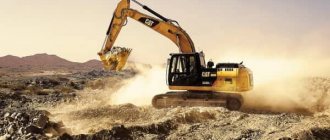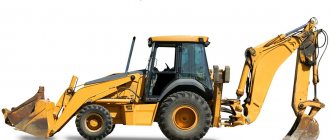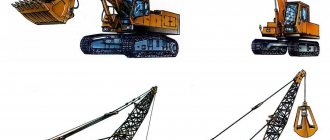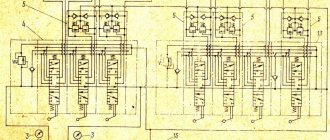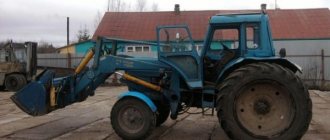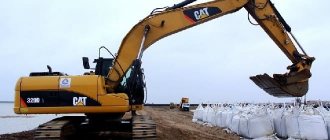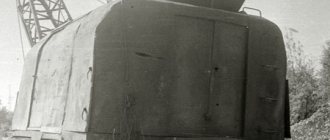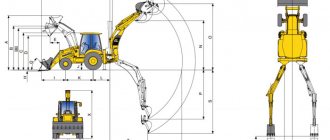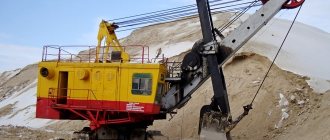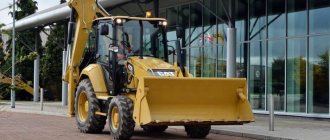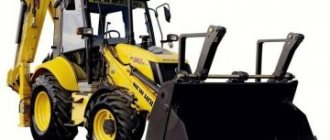general information
Naturally, first of all, classification is carried out depending on the power of the units, as well as their purpose. There are a number of machines that carry out all the necessary operations in order, and then repeat them at regular intervals. Such equipment belongs to discontinuous (cyclic) machines. The general classification of excavators includes another group of devices. But already continuous action. In turn, cyclic excavators are single-bucket, and continuous excavators are multi-bucket, scraper, and milling.
Further, it is worth noting that single-bucket and multi-bucket models can be either land-based or floating. The classification of excavators includes the division of land vehicles according to their method of movement. Thus, there are caterpillar, pneumatic-wheeled, rail-mounted and walking vehicles.
Classification according to various criteria
As mentioned above, such vehicles may have different chassis. In addition to those listed, it can also be a tractor, use a special or combined chassis, or a car drive. As for the principle of operation, the classification of excavators includes one more type, in addition to cyclic and continuous ones - these are vacuum and vacuum-suction. As for their operational purpose, in this case the division into classes is carried out as follows.
There is a group of machines for mining work, that is, for working underground. There is a category of construction universal units. In addition to these two types, the classification of excavators also includes quarry and overburden types.
At the moment, it is customary to distinguish several groups of this transport by their power unit. In this case, excavators can have an internal combustion engine, usually a diesel engine, an electric motor, or steam engines. Although it would be fair to say that the latter type has been used for quite a long time and is now actually not used.
In this article you will learn:
- Main characteristics of excavators;
- Types of excavators;
- Crawler excavators;
- Wheeled excavators.
Earthmoving work is considered one of the most labor-intensive in construction. It is almost impossible to implement them without the use of specialized equipment. Therefore, to carry out construction work, specialists use self-propelled earth-moving machines, or excavators. In this article you will learn everything about the types of excavators and their purposes.
Single-bucket models. What do they represent?
If we talk about the classification of single-bucket excavators, we can identify several main characteristics according to which they are divided into different groups:
- Possibility of rotating the working body around the supporting surface.
- According to the type of chassis used for movement.
- Type of power unit used.
- Type of mechanical transmission (drive for the working body).
The single-bucket excavator itself is a cyclic earth-moving machine, which is intended for development, that is, digging, moving and loading soil. The working body of such units is a movable bucket, which can have a different volume. It is attached either to the boom, or to the handle or ropes. The classification of single-bucket excavators is one of the most extensive, since they are the most common. They are widely used in the construction industry, as well as in mining.
Benefits of using earthmoving equipment
Such machines appeared on the market relatively recently, but have already gained enormous popularity. This is primarily due to the fact that builders managed to replace many manual operations with automated labor. A traditional bucket can hold about 2-4 meters of earth. The equipment can be used in various conditions and in any weather. The cabins can be heated in the cold season, and in hot weather it is permissible to use cold air. All modifications have built-in headlights. They help illuminate the dashboard. That is, excavators are suitable for performing night work.
Modern models of excavators are distinguished by good maneuverability, maneuverability, compactness, and productivity. If necessary, the bucket can be replaced with other attachments. Thanks to this, excavators can be used to drill wells, drive piles, rescue operations and much more. The most common types of attachments include hydraulic hammers, hydraulic booms, forks, teeth, hydraulic drills, grabs, etc.
Classification by rotation method
In this case, the equipment can be full-rotary or part-rotary. In the first case, parts such as all working equipment, the driver's cabin, the working element and the engine are mounted on a special rotating platform, which in turn is installed on the chassis. Fastening occurs using a special rotating support device or simply a support device. The chassis is able to rotate relative to this device in any direction and at any angle.
Since the purpose and classification of excavators are related, that is, the type of machine chosen depends on their purpose, in some cases a part-rotary unit is selected. In this case, the working equipment of the machine will be fixed to the chassis using a special rotary column. The column itself is attached to special transverse guides. This design allows you to move the column and the equipment installed on it left and right. At the same time, there is the possibility of subsequent fixation so that it is convenient to position the bucket in the right place. For such excavators, the working body can rotate at an angle of 45-90 degrees from its original position.
Walking excavators:
A walking excavator is a rotating platform on a base plate with the working equipment of a walking excavator installed on it.
Additionally, the platform is equipped with paws that ensure the movement of equipment, which during operation are in a raised position (do not rest on the surface of the ground). The movement itself is carried out by lifting the base plate from the ground by lowering the paws to the ground, which is a step of the machine (mostly forward, but in some models there is also a reverse move), after which the paw is raised and returned to its original position for subsequent lowering (stroke). ). After which the cycle of movement of the walking single-bucket excavator is repeated again.
Walking excavators are usually equipped with fairly large buckets - from 15 to 40 m3, the boom reach can range from 65-150 m.
Only a dragline is used as working equipment.
Walking type excavators are used :
- during stripping operations (removal of waste rock from mineral deposits);
- when developing the subsoil of the earth and minerals;
- when moving mined minerals.
Excavator on tractor chassis
The first option is mounted on tractors. In this case, a tractor, usually wheeled, is used as the main chassis. All excavator equipment is mounted on the rear or side of the tractor (much less commonly). For this purpose, the vehicle has a special frame. The most common model is working equipment mounted on a class 1.4 tractor. Its bucket volume ranges from 0.2 to 0.5 m3.
Types of working parts of backhoe loaders
Most types of backhoe loaders traditionally have a blade or wide bucket installed at the front. Today, the design of a universal working body, the so-called jaw blade, is gaining popularity. At the top of such a blade, a U-shaped metal plate (jaw) is hinged, which is controlled hydraulically. In the lower position, the jaw adjoins the lower edge of the blade and forms a bucket. The jaw also performs the function of grasping single large objects.
Backhoe loader operation
Several characteristics are used to select a blade:
- blade width and height;
- volume if the blade is equipped with a jaw or a bucket is installed instead;
- the ability to lift, rotate and tilt the blade relative to the machine.
A boom with a shovel (bucket) is mounted in the rear part. The boom can have from 2 to 3 elbows, and can also be equipped with a telescopic part to increase the depth and radius of digging. When describing the types of backhoe loader buckets, the following characteristics are used.
- Shovel type:
- straight - scooping of the load occurs when the bucket moves away from the machine;
- reverse - when scooping, the bucket moves to the backhoe loader.
- Bucket volume.
- A mass that can be lifted and moved by a bucket.
- Bucket width. An important characteristic when digging a trench of a certain width.
- Maximum depth relative to the plane on which the backhoe loader stands.
- Radius of the working area.
Almost all modern types of backhoe loaders, in addition to standard equipment, are equipped with additional, removable working parts.
Other chassis types
In some cases, a truck may be used as the main chassis. Usually these are models with increased cross-country ability. They are distinguished by a fairly high speed of movement, which distinguishes them from other models. They are most often used in areas where high mobility is required. This can be in rescue operations, the military industry, sometimes during road construction or during debris removal.
Pneumatic wheeled excavators have their own special type of chassis, which rests on wheels with pneumatic tires. Typically, such models belong to the full-turn class. The travel speed on such a chassis is no more than 30 km/h, however, they can be towed by trucks at a speed of up to 40 km/h. As for bucket volumes, in this case the range of indicators is quite wide from small (0.04 m3) to heavy models with a volume of 1.5 m3.
Tracked models are very common. Such machines have a specific chassis, which is made in the form of tracks and has a tracked drive. Such models are full-rotary and also have high cross-country ability, thanks to a specific chassis. However, the speed of movement of such equipment is extremely low and amounts to only 2-15 km/h. Typically, special tractor-trailers are used to transport them. If we talk about the characteristics of the bucket, the range also starts from 0.04 m3 and can reach the volume of quarry equipment, that is, 10 m3.
In addition to the listed types, railway, floating or walking methods of transportation are also used. Floating excavators are mounted on pontoons, while railway excavators use the railway as a chassis. And walkers have a special plate to which the paws used for moving are attached.
Bulldozer blade
In terms of digging force, crawler excavators have some advantage due to greater stability. This disadvantage of wheeled vehicles is overcome by using a bulldozer blade and outriggers as support. The blade provides a larger contact area with the ground than two outriggers and improves the stability and lifting characteristics of the excavator. There are models of wheeled excavators equipped only with outriggers, but most are also equipped with dozer blades.
Some buyers of wheeled excavators refuse such an option as a dozer blade (possibly to save money). Nevertheless, experts recommend equipping excavators with both a blade and outriggers. The dozer blade allows you to level soil and materials: for example, if a wheeled excavator is equipped with a toothless bucket (with a smooth cutting edge), the operator can use it together with the dozer blade to level soil and materials, so the wheeled excavator can perform grading work even more efficiently and backfilling of trenches and holes. And the improved blade with parallelogram suspension performs even better backfilling of trenches and clearing work. If you need to move, for example, a large diameter pipe and you have a bucket or thumb grip, place the pipe in front of the blade, clamp the pipe between the tool on the handle and the blade, lift it and carry it to the desired location.
Hyundai is also paying serious attention to compact wheeled excavators in the weight segments “up to 17 tons” (model R55W-9A, HW140 – new for 2016) and “from 17 to 20 tons” (HW180 and HW210 – new for 2016) . ). Wheeled excavators of the HW series have a weight from 13.88 to 21.2 tons and engines with power from 111 to 129.4 kW. The cars reach speeds of up to 35–39 km/h. The electronic control system has an economical ECO mode, fuel savings compared to previous generation excavators are 15–20%, while loading the dump truck is 3–15% faster. An electronic system controls the flow rate in the hydraulic circuit of the attachment. The joints between the boom and the bucket arm have been improved - the bushings and pins have become more wear-resistant. The AAVM video system shows the car from a bird's eye view. The IMOD system warns when a person or object approaches the excavator's working area closer than 5 m. Available in single- and dual-section booms, different length bucket arms, front and rear outriggers, and front and rear blades.
Maud. R55W-9A weighing 5.55 tons has a boom rotation device: 80° to the left and 50° to the right.
Part 1 Part 2
Detailed description of different types of equipment
The classification of continuous excavators begins with the direction of movement of the cutting edge of their bucket.
If we talk about machines with longitudinal digging, then the movement of the cutting edge of their bucket will coincide with the direction of their movement. Typically used only for developing narrow trenches.
For units with a transverse type of digging, the buckets move perpendicular to the movement of the machine itself. Typically used for digging pits during mining.
Excavators with radial digging are very different from the first two types, since in them the movement of the bucket is determined by the rotary rotation of the telescopic boom. In this case, it is worth saying that this category is divided into two more small subgroups, depending on the method of attaching the buckets to the boom. These can be chain or rotary models.
Division by other characteristics
The classification of rotary excavators includes two types of machines. For the first group, the working elements will be placed along the rim of the rotor, for the second group - on the side surface of the rotor. In any case, the buckets will be fixed to a rigid rotor, and soil can be loaded either from the buckets themselves or using a special conveyor.
For chain models, the buckets are attached to an endless chain or chains. As for loading, it is carried out from the buckets themselves, and the shape of the guide chain will determine the digging profile.
As for the classification according to the type of chassis used, they can only be tracked or on pneumatic wheels. If we talk about classification by drives, then machines can be of mechanical, hydraulic, electric or combined type.
Partial rotation excavators:
For semi-rotary excavators, the working equipment is attached to the chassis using a rotating column, the installation of which involves the presence of transverse guides. As a result, the column can be moved along with the working equipment to the right and/or left side with further rigid fixation, which ensures ease of use and durability of the equipment. The rotation angle is limited and ranges from 45-90 degrees. The remaining components of the structure - the cabin, engine and other mechanisms - are mounted on a fixed chassis.
Currently, tractor-mounted excavators are mainly produced as semi-rotary ones.
Career models of units
The classification of quarry excavators remains relevant for study to this day, since minerals are still predominantly mined by open-pit mining, which means that such equipment remains in demand. Such machines themselves differ from others in their much larger dimensions and bucket dimensions, as they are designed to work with huge volumes of soil.
- A conventional mining excavator is an ECG. In this case, it means that the equipment is installed on tracks, and its bucket is mounted on a rope.
- Machine type EG. As for the type of chassis, it is also tracked, but instead of a rope, it uses a hydraulic system to lift the bucket.
- EGO is a mining excavator with a reverse shovel installed.
- EDH is the latest type of quarry equipment. A crawler type chassis is used, and a dragline acts as a mounted working body.
History of excavators - part 1
The history of earth-moving equipment, in particular excavators, can begin to be written from the beginning of the 15th century, when the Venetian edition of the Codex Giovanni Fontana of 1420 published a story about a bucket dredge used to deepen the bottom of canals and expand sea harbors. But officially the idea of creating earth-moving machines belongs to Leonardo da Vinci, who at the beginning of the 16th century. proposed designs for dragline excavators. A sketch of a drawing of a grab for an excavator dates back to 1500. A few years later, Leonardo supervised the construction of canals in the arid Milan Valley. For excavation work, he used a dredger of his own design.
In the scientist’s notebooks, along with drawings of the aircraft, there are sketches of a dredge with a dragline bucket, as well as a structure reminiscent of an excavator. The dragline, proposed by Leonardo da Vinci, is basically reminiscent of the bucket of a modern excavator. Here is its description: “The ladle, pointed like a ploughshare, in front and behind, has a sieve. This will scoop up a lot of soil and allow water to drain. The bucket will be suspended on ropes that are wound around a winch located on the pontoon. The bottom of the bucket can also be hinged, making it easier to unload.” Nowadays, however, dragline buckets with a hinged bottom are not produced, but this principle is successfully used in buckets for straight shovels.
In 1597, a floating dredge was designed and built to clear canals in Venice. Its author was the Venetian mechanic Buanaiuto Lorini, who described the structure of the machine in the work “Delle Fortificazione”. Then, in 1718, a project for an earth-moving device with two buckets was presented to the French Academy of Sciences by mechanics de la Balme and Belidor. The mechanism operated in the ports of Toulon and Brest. Then in 1795, the famous American inventor who created the first practically usable steamship, Robert Fulton, also designed the first four-wheeled grader-elevator. However, the machine was tested only 70 years later on road construction in America. But in 1796, during dredging work in the English port of Sunderland, a bucket dredge driven by a steam engine was used. It was built with the participation of the inventor of the steam engine, James Watt. In one working stroke, the buckets retrieved up to one and a half tons of soil from the bottom of the harbor, which was approximately 4 times higher than the productivity of a hand dredge. The French made a great contribution to the development of excavator technology: in 1860, engineer M. Couvre created a land chain bucket excavator with a 15 horsepower engine. It was tested on the construction of the Sedan-Thionville road, and later worked on the construction of the Suez Canal. And already in 1862, the first steam roller with both driving axles appeared on the streets of Paris. The inventor of the machine was the mechanic Baleison. However, steam rollers did not become widespread. Indeed, to maintain the required pressure in its boiler, it was necessary to burn 60-80 kilograms of fuel per hour.
At the beginning of the 20th century, with the development of the electric power industry, excavator designs also developed by leaps and bounds. In 1905, the first steam full-rotary (with a rotating cabin) excavators were produced by the German company Orenstein & Koppel. The buckets of these machines could hold up to 4 cubic meters of earth. In 1910, the first electric excavators appeared, and the American company Busyrus released a fully rotating crawler excavator. Beginning in 1912, the first crawler-mounted excavator with an internal combustion engine began operating.
Russian inventors proposed many interesting devices that helped ease hard work in the construction of canals, roads, bridges and other structures. So, at the end of the 20s of the 19th century, the Rzhev tradesman Nemilov appeared in St. Petersburg. He had already built many mills, dams and bridges, using ingenious machines of his own design and manufacture. So now he submitted the drawings to General Betancourt for conclusion: “Machines for leveling the land at the foot of the river”, “Machines for lining the soles between pillars with granite stone slabs” and “Copra of a special design, which have not yet been seen anywhere.” Three times Nemilov had to renew his passport in the capital, he never received an answer and returned home with nothing. But these projects, if they had been approved and accepted, could have played a significant role in the development of construction machines.
In those same years, in St. Petersburg, in the attic of one of the houses on Gorokhovaya Street near the Kamenny Bridge, lived the “passionate mechanic” Kazamanov. Having no funds, no materials, no tools, he still managed to build models of his inventions, among which were a kind of pile driver for driving piles, and a machine “for lifting heavy objects with greater ease and convenience to a hill.” The technical innovations created by these and other unknown self-taught inventors found neither proper understanding nor proper distribution. Maybe Russian dredgers were a little more lucky. The first floating dredge was created at the St. Petersburg Institute of Railways in 1809. Its power was 15 horsepower. Such a device could replace the work of many people. This machine was intended for cleaning water bodies. In 1811-1812, the dredger was built at the Izhora plant. From 1813 to 1819, the machine worked to clean up the Kronstadt port.
Later, improved designs of dredgers were proposed in Russia and abroad. But it was, perhaps, one of the first multi-bucket excavators.
In 1847, the Russian inventor Kushelevsky took another step in this area. He proposed the idea of a dredging machine that could work both on water and on land. This machine combined the advantages of a river dredge and a land excavator.
In 1854, materials prepared by a commission studying the natural resources and economy of the Perm province were published in St. Petersburg. They published interesting information about the first Russian steam excavator, which the authors of the document called the “earthen mechanism.” The commission members were unable to determine who built it. It was only known that this unknown mechanic was from Nizhny Tagil, but the described machine essentially did what an excavator does: it could move and “through special devices,” the description of the machine said, it dug ore and removed it from face, preparing the work front for further ore extraction. Thus, almost 130 years ago in Russia, in the Vysokaya Mountain mine in the Urals, a method of open-pit mining using an excavator was used.
The production of single-bucket excavators in Russia began in 1901 at the Putilov (now Tver Excavator) Plant. In the USSR, the production of excavators was organized in 1931. The first 15 machines were produced. Since 1947, the Ural Heavy Engineering Plant (UZTM) was the first in the world to organize the serial production of mining excavators with buckets with a capacity of 3-5 m3. In 1958, UZTM produced a walking dragline excavator with a 25 m3 bucket and a 100 m boom, and in 1965, at the Novokramatorsky Machine-Building Plant (NKMZ) a shovel excavator with a 35 m3 bucket for hard soils was manufactured. In 1975, UZTM completed the production of a walking dragline with a bucket with a capacity of 100 m3 and a boom of 100 m. UZTM mastered the most powerful quarry shovel, with a 20 m3 bucket, for hard soils (1976).
